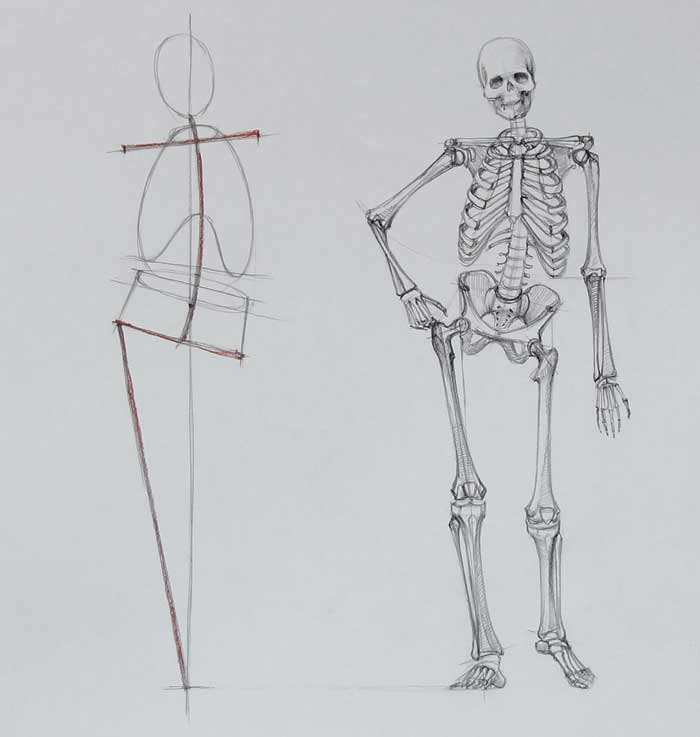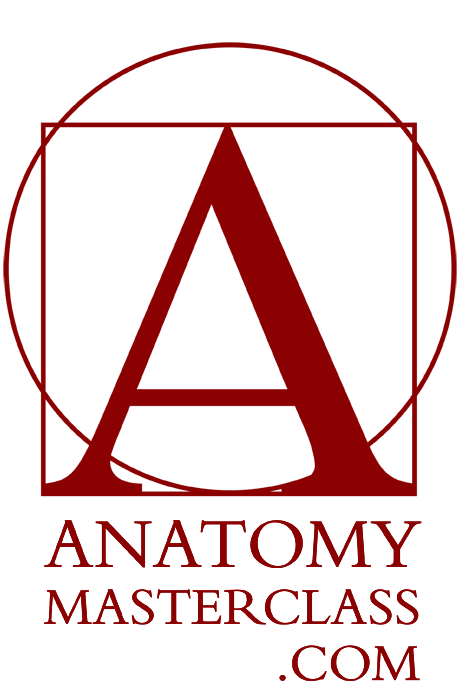Human Body Skeleton
Human Body Skeleton
Anatomy Lesson 4 – Part 1
In this video lesson, you will discover how to draw a human body skeleton in contrapposto position.
Human Body Skeleton in Contrapposto
In such a pose, the human body skeleton has several distinct characteristics.
The axis of the pelvis is tilted, and therefore the spine is curved.
The head is also slightly tilted to the side of the engaged leg.
The anatomical center of the figure is aligned with the pubic bone.
The axis of the shoulders is tilted in the opposite direction to the tilt of the pelvis. The axis of the shoulders as well as the pelvic axis is almost perpendicular to the spine.

The axis of the engaged leg, which supports the body’s weight, runs at an angle to the point on the ground directly below the body’s center of gravity. This center of gravity is located on a vertical line just above the pelvic axis.
The ribcage has its pointing end at the top part of the human body skeleton, running from the first pair of ribs. This pair of ribs has an oval shape and determines the thickness of the neck.
Starting from the first pair of ribs, the ribcage runs downwards, becoming wider, and reaches its widest point at the 8th rib pair.
The axis of the pelvis’ iliac crest is also tilted downward.
In this video lesson you will also discover a detailed explanation of human body skeleton proportions.
The classical proportion of the human body skeleton is when the head fits 8 times into the body height.
The length of the breastbone is equal to the height of the face.
The Latin word pelvis means “basin.” In fact, this skeletal structure is shaped like a basin or a bowl and holds the internal organs in humans, unlike in animals whose internal organs are not supported by the pelvis.
In this course, you will watch a video lesson specifically dedicated to the anatomy of the pelvis.
The bones of the pelvis in an adult are fused together, forming a single unit that do not move independently of each other. The pelvis consists of three bones: two hip bones and one sacrum bone. The axis of the pubic bones is aligned with the hip joint, which connects the hip and the thighbones. In the lower part of the pelvis there are two bones, which support the body when it is sitting. This bone is called the ischium. Its lower part resembles a bagel.
The sacrum has a triangular shape, with its peak facing downward. It is located at the base of the spine, in the middle of the pelvis. It is, in fact, five vertebrae of the spine, which begin to fuse together around 16 to 18 years of age and are completely fused by the age of 34.
The spinal column runs upward from the sacrum.
The upper leg bone is connected to the pelvis via the hip joint. It is the “ball and socket” joint, which means that the round head of the upper leg bone, called the femur fits inside the pelvic “socket”.
The distance from the iliac crest to the toes can be divided in half. In the middle it will be the top edge of the kneecap.
So, the distance between the top edge of the breastbone and the pubic bone is equal to the distance between the iliac crest and the top of the kneecap, as well as the distance from the kneecap to the toes.
The axis of the femur and the axis of the lower leg do not lie on the same line; there is an angle between them.
The length of the breastbone is equal to the length of the collarbone.
The breastbone is called the sternum, and it resembles a necktie. The ribs are attached to this bony structure. The sternum consists of three sections: the manubrium, the gladiolus, and the xiphoid process.
The collarbone (Latin name clavicle) at its inner end is connected to the manubrium of the breastbone.
The notch between the two clavicles at the top of the breastbone is called the pit of the neck, or suprasternal notch. This space is important to mark correctly when drawing a model.
The outer end of the collarbone is connected to the shoulder-blade, which has the Latin name scapula.
The part where the spatula connects to the collarbone, is called the acromion of scapula.
Just below the acromion of scapula I have marked the head of the upper-arm bone. This round head is similar in size to a golf ball.
The upper-arm bone is called the humerus.
The elbow joint is approximately on the same level as the lower edge of the ribcage.
The upper-leg has one bone, the femur. This bone is mostly located deep inside muscles; however, its upper part, called the greater trochanter, comes close to the surface near the hip and is an important landmark for artists to know and use in drawings.
The lower end of the femur and the knee-joint is protected by the knee-cap, which is called the patella. Quite often, amateur artists ignore this important bone when drawing legs, without which knees don’t look realistic.
The lower-leg has two bones. The larger bone, the shinbone, is called the tibia. Its shaft has a triangular cross-section. In the front, this bone is not covered by muscles and comes very close to the surface of the skin.
The second bone of the lower-leg is the calf-bone; it has the Latin name fibula. It is located next to the shinbone on the outer side of the leg. The calf-bone is more slender than the shinbone. Its upper head can be detected on the side of the leg, a bit lower than the knee-joint.
The forearm, like the lower-leg, also has two bones. The longer one is called the ulna. You can feel the entire length of this bone under your fingers, starting from the elbow all the way to the wrist, to the side of your little finger side.
The other bone of the forearm is called the radius. It can rotate around the ulna. When these two bones cross, this position is called pronation. When these bones are parallel, this is called supination.
The ulna is wider towards the elbow and slimmer at the wrist, while the radius is narrower at the elbow and wider by the wrist.
The ribcage, or thorax, has 12 pairs of ribs.
The circle of the first pair of ribs marks the width of the neck.
The first rib is connected to the breastbone, just under the collarbone. The second rib connects to the breastbone, or sternum, just between the manubrium and gladiolus. It is horizontal at the front and turns slightly upward toward the spine.The third rib turns slightly downward from the breastbone. Each subsequent rib makes a wider perimeter compared to the previous one, making the ribcage ever wider.
In front, the first seven pairs of ribs are connected to the breastbone and are called true ribs. Rib pairs 8, 9, and 10 each connect to the rib above and are called false ribs. The last two pairs, the 11th and 12th ribs, are only connected to the spine and are called floating ribs.
One of the most interesting parts of the human body skeleton is the skull. A human skull has a quite complex structure, consisting of 22 bones (not including the teeth).
All the major bones of the skull, apart from the lower jawbone, are fused together, forming a rigid structure that protects the brain, the most vital organ in our body.
The eye-sockets are located in the middle of the head. Avoid the amateur’s mistake of placing them too high.
The lower edge of the cheekbone and the root of the nose lie on the same line, which is a third of the way from the lower edge of the skull.
The human hand has 27 bones. In this video, we will skip its detailed anatomy; a separate video will treat in detail the bones and muscles of the human hand.
All the bones of the hand are divided into three groups:
- The carpal bones, or wrist bones;
- The metacarpals, which are the hand-block bones;
- And the phalanges of fingers.
The foot also contains three groups of bones:
- There are 7 tarsal bones;
- 5 metatarsal bones;
- And 14 phalanges of toes.
[ The full lesson is avaibale to Anatomy Master Class members ]
To learn more about Human Body Skeleton, enroll in the Anatomy Master Class
Simple Pricing, No Surprises
One-time payment - Only $97 USD
ENROLL NOW



